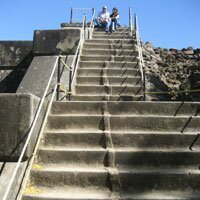
This is a battle dance of "Lenca" origin. It is also danced in the Indian towns of the East of the country. The number of Indians that participate vary between four to twelve. They carry somewhat long lances with a metal point and decorated with metal curls. This lance is called "Partesana". Another group of Indians of equal number accompany them carrying banners, batons decorated with ribbons, bows decorated with relics and woolen balls. The dancers thrown their lances to the sky and capture them on their way down after having made many turns in the air. There is a time when all the lances are in movement creating a battle effect.
It is a very ancient dance of Indian origin. It is executed in almost all Indian towns in the country. The main dancer is disguised with wild pig skins and in the dance imitating the animal running. Also, there appears a man on the scene elegantly dressed and an old lady with a traditional outfit of the region and a big hat decorated with paper flowers. Another man disguised as a dog conducts de chorus. The members of the chorus are dressed with small shorts and small "pacaya" leaves skirts with colorful feathers on the head armed with bows and arrows or with wooden lances or long twigs from the "huizcoyol" tree.
"This brought the torito
to eat grass in the bucket
only to come to dance
before the Lord Mayor".
"This brought the torito
San Cruz Michapa
and today I am going from here
not take that chata".
|
This dance is executed in the town of Panchimalco. Twelve gentlemen dressed in tuxedos and in shoes appear. A lady dressed in white that represents the Queen and is wearing a headband on her head accompanies them. The dance imitates Spaniard manners and ridicules them with ceremonious and languid movements to the music of a delicate waltz. This dance is from "Lenca" origin and is executed by Indian towns in the eastern region of El Salvador. The center dancer imitates a mare, dancing barefoot or with sandals wearing a very well imitated horse head, a pack tied to his waist and a hind tail. Four Indians dance around the mare with wide sticks in their hands. This dance ends simulating a fight. The mare intervenes during the fight, separates them ending the fight by kicking and thumping all around, which is her principal role in the dance. |
Mission Statement
The mission of CEA is to increase awareness of Salvadoran Culture & History within our local & international community. CEA will accomplish the awareness by providing Cultural & Educational services in our communities, both local and international.